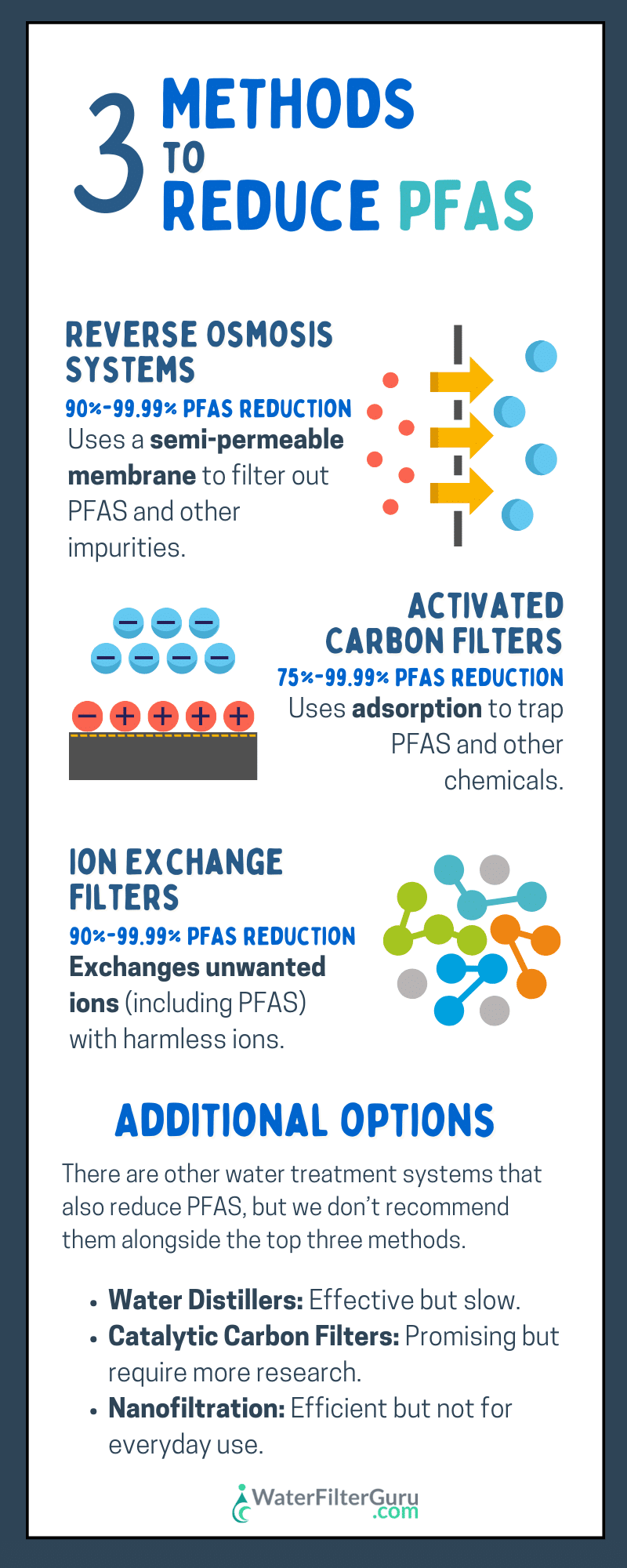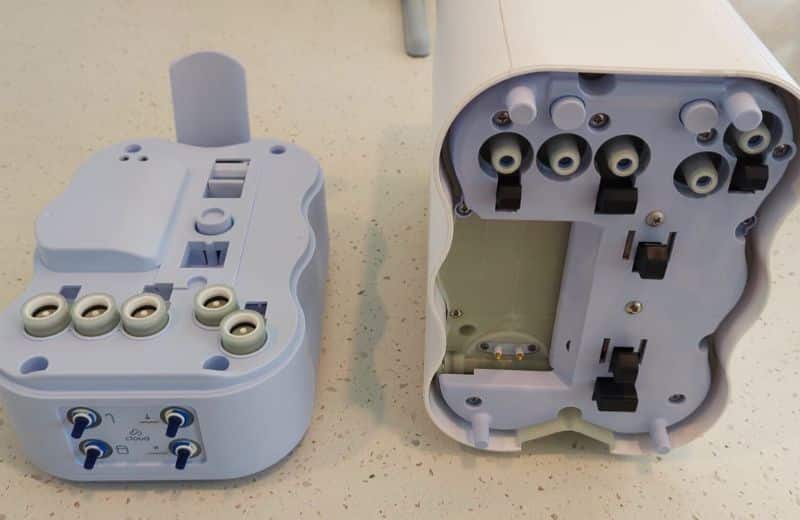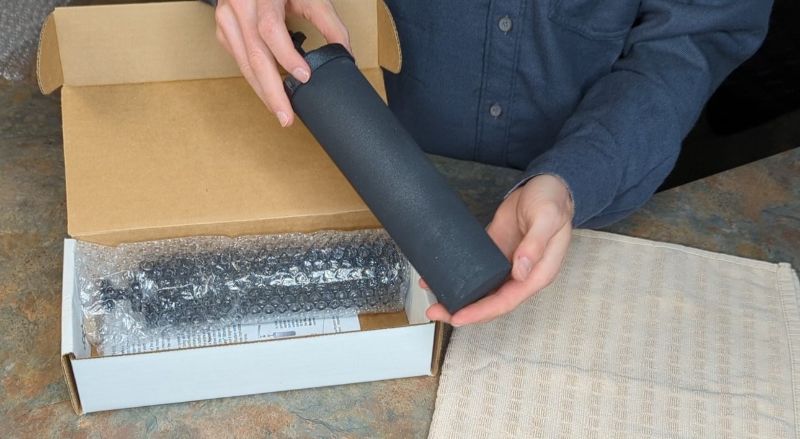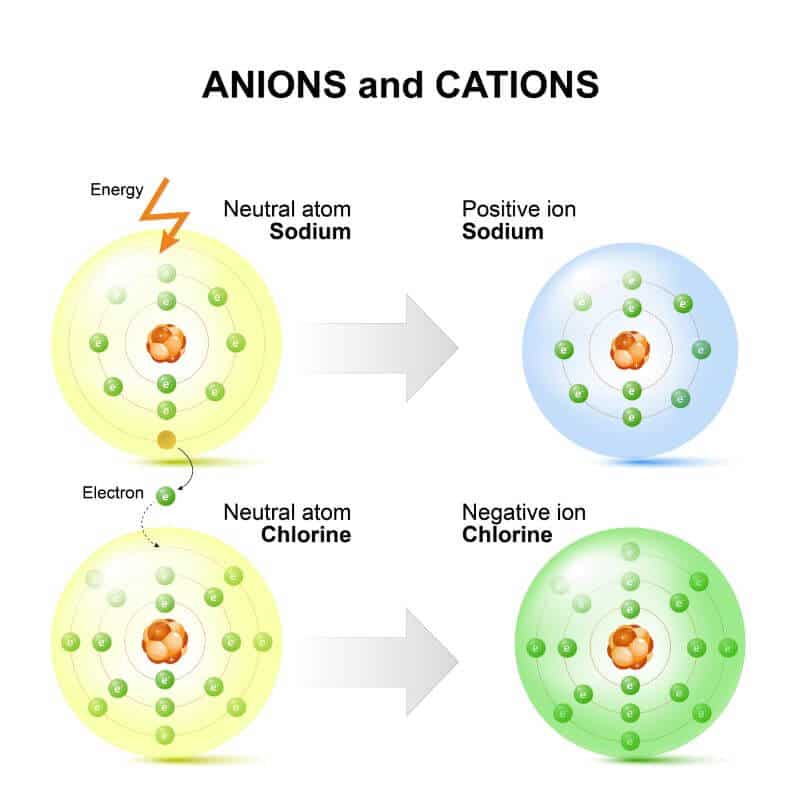PFAS chemicals pose a significant health risk and are toxic even at low levels. Concerningly, scientists have found that these chemicals are commonly found in tap water – a 2023 study by Environmental International estimated that 45% of US drinking water samples contained at least one PFAS chemical.
At Water Filter Guru, we conduct hands-on testing of dozens of water filters every year, using our own data to determine which ones are best for different situations. Here, we’ve listed the most effective methods we’ve tried – supported by real data – for addressing PFAS contamination in your water.
📌 Key Takeaways
- The best methods to remove PFAS from water include using reverse osmosis systems, activated carbon filters, and ion exchange filters.
- Boiling water, KDF filters, activated alumina media, and ceramic filtration are NOT effective ways to remove PFAS.

Table of Contents
⚗️ Reverse Osmosis Systems
PFAS reduction rate: 90%-99.99%
Reverse osmosis water filtration is one of the most effective ways to greatly reduce PFAS and hundreds of other impurities in drinking water.
How it Works
During the reverse osmosis process, water is forced through multiple filtration stages, including a semi-permeable membrane, which has tiny pores of around 0.0001 microns. PFAS chemicals and other impurities exceeding the membrane pore size can’t pass through and are removed from the RO unit with wastewater.
RO systems can reduce up to 100% of dozens of PFAS chemicals. The semipermeable membrane rejects the majority of dissolved solids. Reverse osmosis units also use activated carbon filters, which are effective PFAS reduction solutions alone (see the next section).
Reverse osmosis filters may be point of entry – installed at your main water line to provide whole house filtration (less popular) – or point of use – installed as under-sink or standalone countertop units to treat drinking water only (more common).

The Evidence
Of all the water filtration methods we researched, reverse osmosis is the most data-backed PFAS reduction solution.
Here are some of the studies we found:
- This study by Duke and NC State scientists noted that the under-sink RO systems tested achieved “near-complete removal” of the PFAS chemicals in the test water.
- The EPA cites reverse osmosis as an “extremely effective” method for removing PFAS.
- A 2020 study by EPA researchers found that point-of-use and point-of-entry RO systems could reduce PFAS to “below laboratory detection limits”.
Best For
RO filters are comprehensive water purification systems for folks willing to spend more money upfront on a filter that greatly reduces PFAS and hundreds of other contaminants.
🔮 Activated Carbon Filters
PFAS reduction rate: 75%-99.99%
Activated carbon filters, typically in granular form, are the most affordable method of addressing PFAS in drinking water.
How it Works
Activated carbon filters are highly porous and have a large surface area, using a process called adsorption to trap to trap organic pollutants, some VOCs, and chemicals, including PFAS.
Granular activated carbon can be 100% effective at removing PFOA & PFOS, according to the EPA, for a limited period of time – and this depends on several factors, such as water temperature and flow rate, the depth of the carbon bed, and the types of PFAS you need to remove.
Carbon filters are commonly used in affordable POU water filtration systems, like water filter pitchers, faucet filters, and countertop filters. They’re also used in under-sink and whole-home filtration systems.

The Evidence
We found numerous studies discussing the effectiveness of activated carbon in reducing PFAS. The type, design, and quality of the carbon filter used affect the results; some studies found that PFAS could be eliminated entirely, while others noted that activated carbon only reduced these chemicals by around 75%.
Here are some studies we want to highlight:
- This 2022 study on granular activated carbon for PFAS removal concluded that GAC was an “effective treatment technology” for this purpose.
- Another analysis of PFAS removal efficiency by GAC found that carbon media in granular form could effectively reduce concentrations of PFOS and PFOA greater than 95% (depending on the quantity of water treated). But it also noted that GAC treatment isn’t as effective for short-chained PFAS, like PFHxA and PFBS.
Best For
Activated carbon filters work best for reducing long-chain PFAS like PFOS and PFOA. They’re best suited to folks who have smaller budgets and want a more affordable solution. Not all carbon filters address PFAS, so we recommend looking for a filter that’s certified to NSF 53 for PFOA/PFOS reduction.
📤 Ion Exchange Filters
PFAS reduction rate: 90-99.99%
Ion exchange systems have also been proven in numerous studies to reduce or remove PFAS in water, and, unlike activated carbon, they’re effective in reducing short-chain PFAS.
How it Works
Ion exchange resins may be used in a filter cartridge or a regenerating point-of-entry water treatment sytsem.
Many water pitcher filters contain ion exchange resins alongside activated carbon media, enhancing their overall PFAS reduction abilities.
When water flows through an ion exchange resin, the unwanted ions are exchanged with non-harmful ions pre-loaded in the resin.
In a water filter, the resin eventually becomes saturated with unwanted ions and must be replaced. In a regenerating system, the resin can be flushed to remove the accumulated unwanted ions and replenish the non-harmful ions, allowing the process to be repeated.
PFAS are usually found in water-soluble anionic (negatively charged) form in most surface waters, so an anion exchange resin is the best type of ion exchange resin for addressing these chemicals.

The Evidence
Here are some highlights from the research into ion exchange systems for PFAS reduction:
- This 2021 review of PFAS reduction by ion exchange found that this water treatment method is an efficient technology for addressing PFAS in surface and groundwaters. The study noted that ion exchange is particularly effective in reducing emerging short-chain PFAS that aren’t removed by carbon-based adsorption filters.
- This 2024 study on the removal of per- and polyfluoroalkyl substances by anion exchange (AE) resins concluded that AE is a readily available treatment method that can “effectively remove anionic PFAS” from water.
Best For
Ion exchange filters are the best PFAS reduction solution for folks who also want to address short-chain PFAS in their water, like PFBS and PFHxS.
Read Our Reviews: The Best Water Filter for PFAs Removal
🚰 Other Filters That Reduce PFAS
There are a few other water treatment systems that also reduce PFAS, but we don’t recommend them alongside the top three methods.
These are:
- Water distillers – These purify water, like reverse osmosis, so they’re a great choice for folks who want to reduce PFAS and many other dissolved solids in their water. But we didn’t recommend them as a top choice because the distillation process takes hours, so they’re not the most convenient solution.
- Catalytic carbon filters – These appear to be effective at reducing PFAS. We found a few catalytic carbon filters in our research that claim to address PFOS/PFOA. But this method of water treatment didn’t make our list because we were unable to find scientific evidence to prove its PFAS reduction abilities.
- Nanofiltration – Nanofiltration is considered an efficient technology for removal of PFAS. However, nanofiltration is typically only used in emergency and survival water filters, rather than in filters designed for everyday use at home, so they’re unlikely to be a practical PFAS solution for many people.
⚠️ Which Water Treatment Methods Are NOT Effective for PFAS Reduction?
There are several water treatment methods that aren’t effective at reducing PFAS in water.
Ceramic Filters
Ceramic filters can’t reduce chemicals like PFAS – they’re typically used to filter particulates and microorganisms from water.
Many ceramic filters have an activated carbon core, which may give them the ability to reduce PFAS (check the filter’s performance data and look for certifications to be certain).
KDF Filters
KDF filters are often used alongside activated carbon filtration media in point-of-use drinking water filters. Depending on the type of KDF media used, this filtration method addresses chlorine, iron, magnesium, lead, chromium, and other metals.
There’s very little research into KDF filters for PFAS reduction, and we couldn’t find any evidence to suggest that these filters work for this purpose.
Boiling Water
Boiling water won’t remove PFOS, PFOA, or any other PFAS chemical, as PFAS don’t evaporate out of water when heated.
In fact, boiling water just causes some of the water particles to evaporate, resulting in the same concentration of PFAS within a smaller batch of water.
Activated Alumina Filters
We found some sources that listed activated alumina as an effective PFAS reduction solution, but we could find no scientific evidence to support these claims.
Activated alumina is predominantly used to address arsenic and fluoride, not PFAS.
Ultrafiltration
Ultrafiltration is similar to reverse osmosis, but with larger membrane pores.
Unlike RO, UF membranes aren’t usually combined with activated carbon filtration, and the membranes alone typically don’t address PFAS because their pores are too large.
📑 Final Word
The right PFAS water filter for you depends on your situation and your budget.
If PFAS reduction is your priority and you want to be certain about a water filter’s abilities, look for one with an official performance certification to NSF/ANSI 53 (or NSF/ANSI 58 for reverse osmosis systems), for the reduction of PFOA/PFOS.
I strongly recommend testing your water to know exactly which impurities it contains before choosing a PFAS removal solution. Many water filters address more than just PFOS and PFAS. Contaminants including lead, chlorine, arsenic, and VOCs are common in tap water and can all be reduced using a single filtration system.
🧠 How to Remove PFAS From Water: FAQ
Can you filter PFAS out of drinking water?
Yes, PFAS can be filtered out of drinking water at home. So if you’re concerned about these chemicals in your water, you can filter them out using a reverse osmosis filtration system, an activated carbon filter, or an anion exchange system.
Do water softeners remove PFAS?
No, water softeners don’t remove PFAS from water. A water softener is an ion exchange system, but it uses cation exchange, not anion exchange, meaning that it can only remove positive ions. PFAS are predominantly negatively-charged ions, so they’re not addressed by a water softener.
What is the best way to remove PFAS from water?
In our opinion, the best way to remove PFAS from water is with a reverse osmosis system, which also reduces up to 99.99% of many other dissolved solids. If you specifically want to address PFAS and several other contaminants, without purifying your water, an activated carbon filter may be better for you.
What is the cheapest method of removing PFAS from water?
If you’re on a budget, the best PFAS reduction solution for you is an activated carbon filter. You can find activated carbon filters in faucet filters, water filter pitchers, and other point-of-use systems that cost less than $100 upfront.
